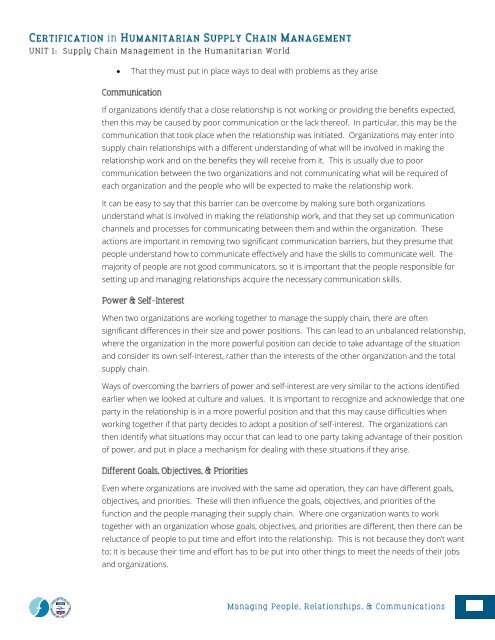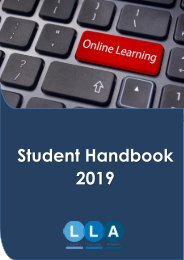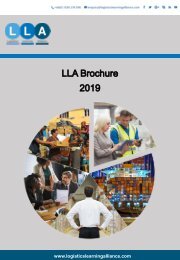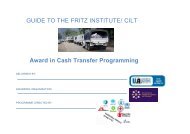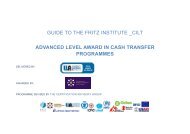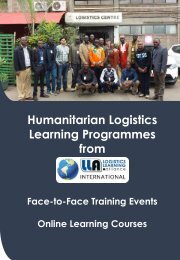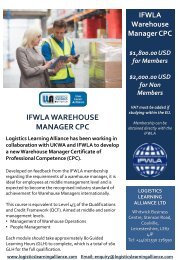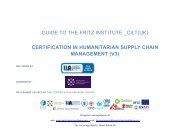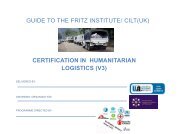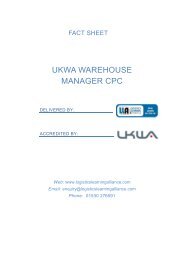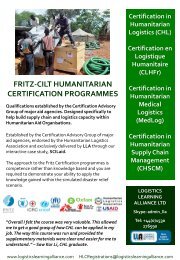CHSCM 3.0 - Unit 1 - SCM in the Humanitarian World
Learning Materials for Unit 1 of the Certification in Humanitarian Supply Chain Management (CHSCM).
Learning Materials for Unit 1 of the Certification in Humanitarian Supply Chain Management (CHSCM).
Create successful ePaper yourself
Turn your PDF publications into a flip-book with our unique Google optimized e-Paper software.
• That <strong>the</strong>y must put <strong>in</strong> place ways to deal with problems as <strong>the</strong>y arise<br />
If organizations identify that a close relationship is not work<strong>in</strong>g or provid<strong>in</strong>g <strong>the</strong> benefits expected,<br />
<strong>the</strong>n this may be caused by poor communication or <strong>the</strong> lack <strong>the</strong>reof. In particular, this may be <strong>the</strong><br />
communication that took place when <strong>the</strong> relationship was <strong>in</strong>itiated. Organizations may enter <strong>in</strong>to<br />
supply cha<strong>in</strong> relationships with a different understand<strong>in</strong>g of what will be <strong>in</strong>volved <strong>in</strong> mak<strong>in</strong>g <strong>the</strong><br />
relationship work and on <strong>the</strong> benefits <strong>the</strong>y will receive from it. This is usually due to poor<br />
communication between <strong>the</strong> two organizations and not communicat<strong>in</strong>g what will be required of<br />
each organization and <strong>the</strong> people who will be expected to make <strong>the</strong> relationship work.<br />
It can be easy to say that this barrier can be overcome by mak<strong>in</strong>g sure both organizations<br />
understand what is <strong>in</strong>volved <strong>in</strong> mak<strong>in</strong>g <strong>the</strong> relationship work, and that <strong>the</strong>y set up communication<br />
channels and processes for communicat<strong>in</strong>g between <strong>the</strong>m and with<strong>in</strong> <strong>the</strong> organization. These<br />
actions are important <strong>in</strong> remov<strong>in</strong>g two significant communication barriers, but <strong>the</strong>y presume that<br />
people understand how to communicate effectively and have <strong>the</strong> skills to communicate well. The<br />
majority of people are not good communicators, so it is important that <strong>the</strong> people responsible for<br />
sett<strong>in</strong>g up and manag<strong>in</strong>g relationships acquire <strong>the</strong> necessary communication skills.<br />
When two organizations are work<strong>in</strong>g toge<strong>the</strong>r to manage <strong>the</strong> supply cha<strong>in</strong>, <strong>the</strong>re are often<br />
significant differences <strong>in</strong> <strong>the</strong>ir size and power positions. This can lead to an unbalanced relationship,<br />
where <strong>the</strong> organization <strong>in</strong> <strong>the</strong> more powerful position can decide to take advantage of <strong>the</strong> situation<br />
and consider its own self-<strong>in</strong>terest, ra<strong>the</strong>r than <strong>the</strong> <strong>in</strong>terests of <strong>the</strong> o<strong>the</strong>r organization and <strong>the</strong> total<br />
supply cha<strong>in</strong>.<br />
Ways of overcom<strong>in</strong>g <strong>the</strong> barriers of power and self-<strong>in</strong>terest are very similar to <strong>the</strong> actions identified<br />
earlier when we looked at culture and values. It is important to recognize and acknowledge that one<br />
party <strong>in</strong> <strong>the</strong> relationship is <strong>in</strong> a more powerful position and that this may cause difficulties when<br />
work<strong>in</strong>g toge<strong>the</strong>r if that party decides to adopt a position of self-<strong>in</strong>terest. The organizations can<br />
<strong>the</strong>n identify what situations may occur that can lead to one party tak<strong>in</strong>g advantage of <strong>the</strong>ir position<br />
of power, and put <strong>in</strong> place a mechanism for deal<strong>in</strong>g with <strong>the</strong>se situations if <strong>the</strong>y arise.<br />
Even where organizations are <strong>in</strong>volved with <strong>the</strong> same aid operation, <strong>the</strong>y can have different goals,<br />
objectives, and priorities. These will <strong>the</strong>n <strong>in</strong>fluence <strong>the</strong> goals, objectives, and priorities of <strong>the</strong><br />
function and <strong>the</strong> people manag<strong>in</strong>g <strong>the</strong>ir supply cha<strong>in</strong>. Where one organization wants to work<br />
toge<strong>the</strong>r with an organization whose goals, objectives, and priorities are different, <strong>the</strong>n <strong>the</strong>re can be<br />
reluctance of people to put time and effort <strong>in</strong>to <strong>the</strong> relationship. This is not because <strong>the</strong>y don’t want<br />
to; it is because <strong>the</strong>ir time and effort has to be put <strong>in</strong>to o<strong>the</strong>r th<strong>in</strong>gs to meet <strong>the</strong> needs of <strong>the</strong>ir jobs<br />
and organizations.


